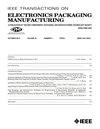Effect of Selected Process Parameters on Durability and Defects in Surface-Mount Assemblies for Portable Electronics
IEEE Transactions on Electronics Packaging Manufacturing
Pub Date : 2008-01-07
DOI:10.1109/TEPM.2007.914222
引用次数: 25
Abstract
This paper presents a systematic approach to study the effect of manufacturing variables on the creation of defects and the effect of those defects on the durability of lead-free (Pb-free) solder joints. An experiment was designed to systematically vary the printing and reflow process variables in order to fabricate error-seeded test assemblies. The error-seeded samples were then inspected visually and with X-ray, to identify different types of defects, especially voids, and then test for electrical performance. The specimens were subjected to an accelerated thermal cycling test to characterize the durability of these error-seeded specimens and to study the effect of each manufacturing variable on the durability of the solder joints. The response variables for the design of experiments are thermal cycling durability of the solder joints and void area percentage in ball grid array (BGA) solder joints. Pretest microstructural analysis showed that specimens produced under inadequate reflow profiles suffered from insufficient wetting and insufficient intermetallic formation. Statistical analysis of the response variables shows that waiting time, heating ramp, peak temperature, and cooling rate have nonlinear effects on thermal cycling durability. Two variables in particular [peak temperature and waiting time (the time waited after the solder paste barrel was opened and before print)] appear to have optimum values within the ranges investigated. Statistical analysis of void percentage area for all design of experiment (DOE) runs show that higher stencil thickness results in higher void percentage and that void percentage increases as time above melt and peak temperature increases.选择工艺参数对便携式电子元件表面贴装组件耐久性和缺陷的影响
本文提出了一种系统的方法来研究制造变量对缺陷产生的影响,以及这些缺陷对无铅(pb)焊点耐久性的影响。设计了一个实验,系统地改变印刷和回流工艺变量,以制造错误种子测试组件。然后用x射线和视觉检查错误种子样品,以确定不同类型的缺陷,特别是空隙,然后测试电气性能。试样进行了加速热循环试验,以表征这些错误种子试样的耐久性,并研究每个制造变量对焊点耐久性的影响。实验设计的响应变量是焊点的热循环耐久性和球栅阵列(BGA)焊点的空隙面积百分比。测试前的显微结构分析表明,在不适当的回流剖面下生产的样品没有充分的润湿和金属间形成。响应变量的统计分析表明,等待时间、加热斜坡、峰值温度和冷却速率对热循环耐久性具有非线性影响。特别是两个变量[峰值温度和等待时间(锡膏桶打开后和打印前等待的时间)]似乎在调查范围内具有最佳值。对所有试验设计(DOE)的空穴百分率面积进行统计分析表明,越大的模板厚度,空穴百分率越高,且随着熔点以上时间和峰值温度的增加,空穴百分率也随之增加。
本文章由计算机程序翻译,如有差异,请以英文原文为准。
求助全文
约1分钟内获得全文
求助全文

 求助内容:
求助内容: 应助结果提醒方式:
应助结果提醒方式:


